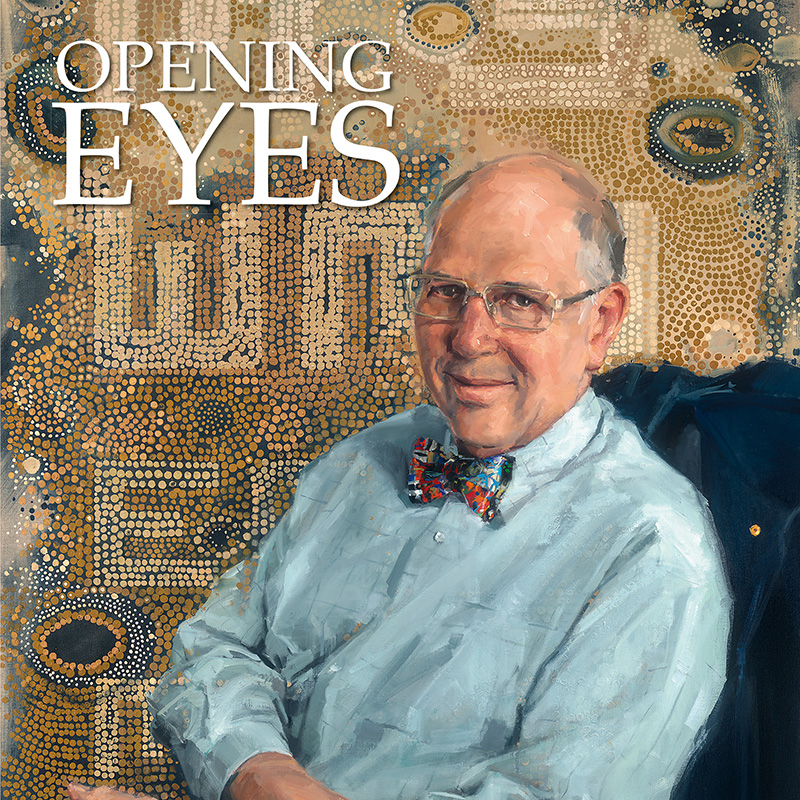News
Legacy of sight put to paper
CERA’s Founding Managing Director Professor Hugh R Taylor AC has spent decades protecting vision by bridging the lab and the clinic. His new autobiography captures that journey.
Professor Hugh R Taylor AC’s new autobiography Opening Eyes chronicles his journey from volunteering with Fred Hollows in Bourke, New South Wales, to his transformative work fighting trachoma and the establishment of the Centre for Eye Research Australia.
His efforts to both understand eye disease and develop community health strategies to reduce their impact – particularly closing the eye health gap for the Aboriginal and Torres Strait Islander population – is a lifelong journey now put to paper.
It was an opportunistic request to travel with Fred Hollows AC on a long weekend to Bourke where he saw firsthand the impact of trachoma while assistant director of the then new National Trachoma Eye Health program.
Trachoma is a bacterial eye infection that affects the inside of the eyelid that can lead to blindness. While it can be treated with antibiotics, it is quite common in remote Australia where there is poor access to water and washing facilities.
“That is what got me interested in community health and Aboriginal health,” says Professor Taylor.
“And later I when I was doing a fellowship at Johns Hopkins University in the United States, at a Christmas party the director of immunology asked if I would do some research on trachoma in the laboratory.
“I sometimes say it’s a bit like sailing – you go along in one direction and then the wind changes, so you tack and take another direction still with the same ultimate goal of doing good.”

The book follows Professor Taylor’s research and community outreach work – which was foundational for the World Health Organization’s strategy for eliminating trachoma and saved the vision of countless people.
The WHO has now validated that 25 countries have eliminated trachoma as a public health problem thanks to the strategy.
Professor Taylor has also played a crucial role in combating river blindness – a blinding disease caused by infection from a parasitic worm.
“I’ve just celebrated the 5 billionth dose of ivermectin for treating river blindness,” says Professor Taylor.
“Our first study had 30 people, the next study had 300 and our last study had 30,000.
“Based on that work, pharmaceutical company Merck decided to provide ivermectin free to treat river blindness.
“It’s all about moving good research into the real world.”
The book also details Professor Taylor’s development of the Melbourne Visual Impairment Project – a population-based survey of eye disease in Melbourne that revealed the unmet need for improved eyecare across the state.
The project let him to set up both the Lions Eye Donation Service and the Centre for Eye Research Australia and is proud of what has been accomplished at the centre in the following three decades.
“It’s fantastic to see it listed in the top four eye research institutes in the world. The work they’re doing is fabulous. The new facilities, the clinical trials centre Cerulea, and the other spin offs they’ve had – I’m so proud of CERA.”
Professor Taylor believes that both gene therapy and artificial intelligence are poised to revolutionise eyecare but like the rest of his story he is still focused on how discoveries in the lab can make their way to the people who need them.
“One of the things that really surprised me with the Indigenous Eye Health survey we did with CERA back in 2015 was the unmet need for Aboriginal and Torres Strait Islander people in Fitzroy, Melbourne, was the same as it was in Fitzroy Crossing in Western Australia.
“The Victorian Aboriginal Health Service is terrific and has made a huge difference, but we have all sorts of underserved communities and groups, and we need to make sure that our quality eye care is reaching everybody who needs it.”
CERA Managing Director Professor Keith Martin says the book captures a remarkable story.
“Hugh’s book is a fantastic read – a wonderful insight into what can be achieved to improve eye health through dedication, determination, focus and political skill.
“As CERA approaches its 30th anniversary, I am proud to lead a pioneering world class institute that is a lasting testament to Hugh’s extraordinary vision.”
Opening Eyes is now available for purchase on Amazon in print, as an e-book and an audiobook.
